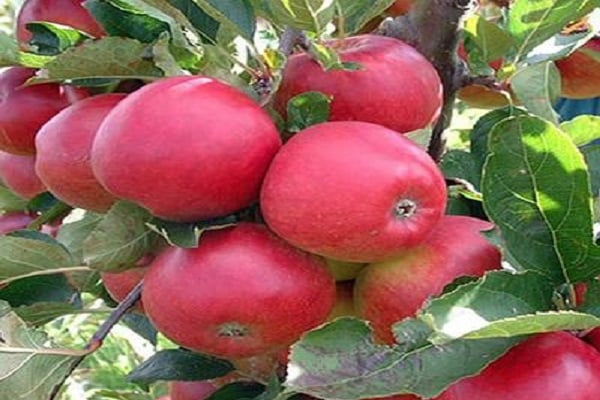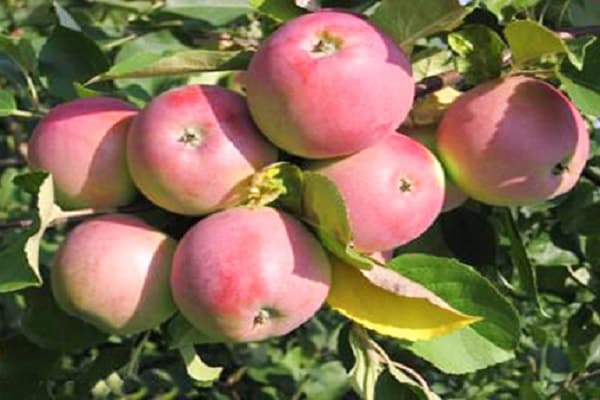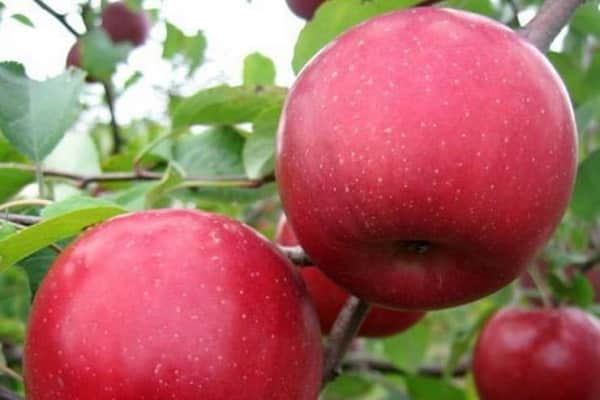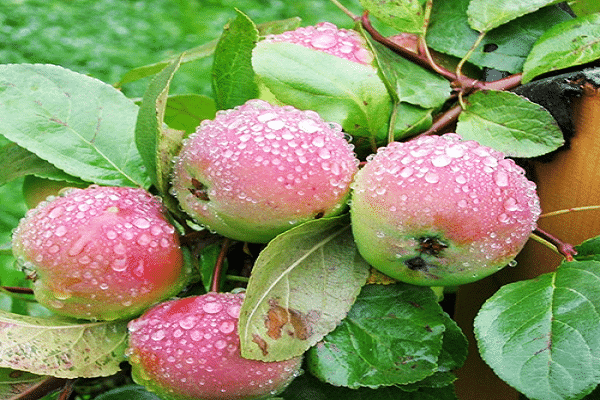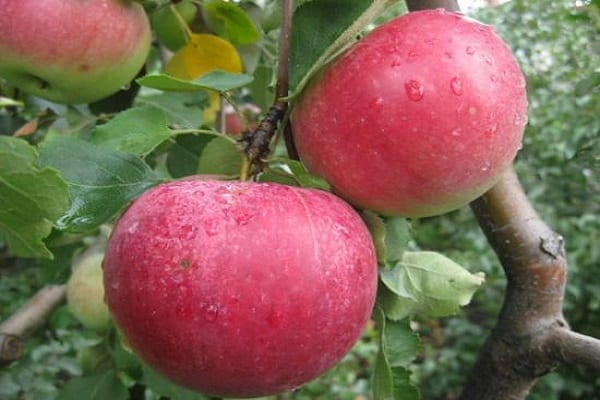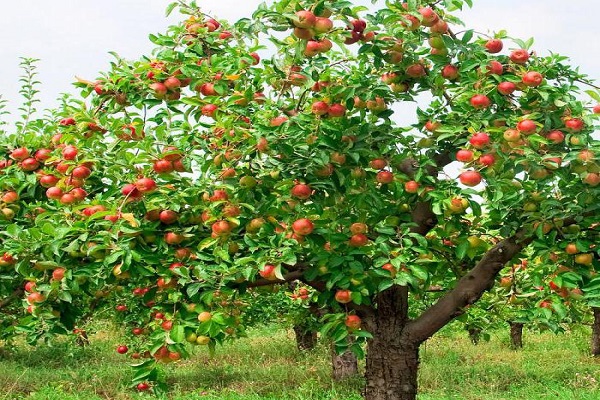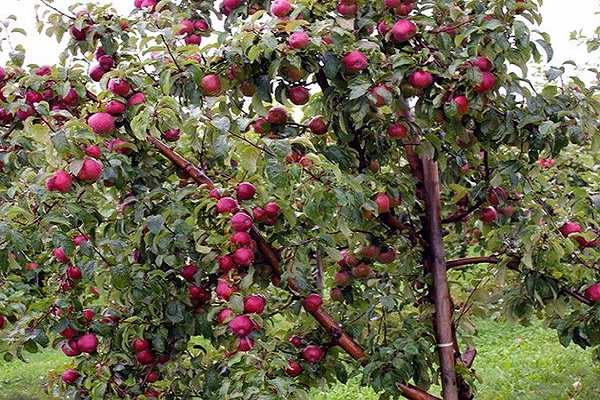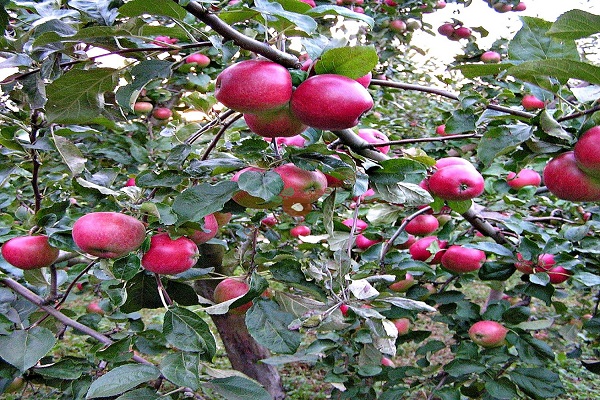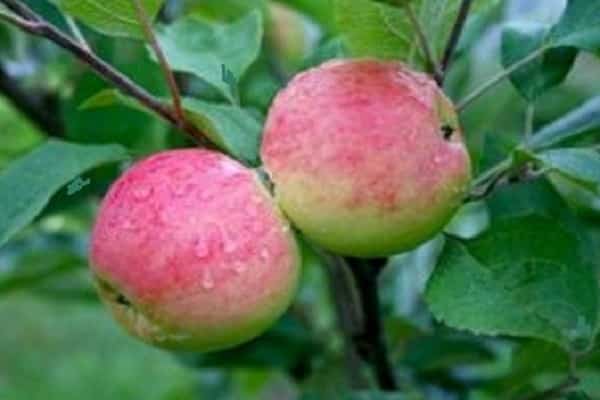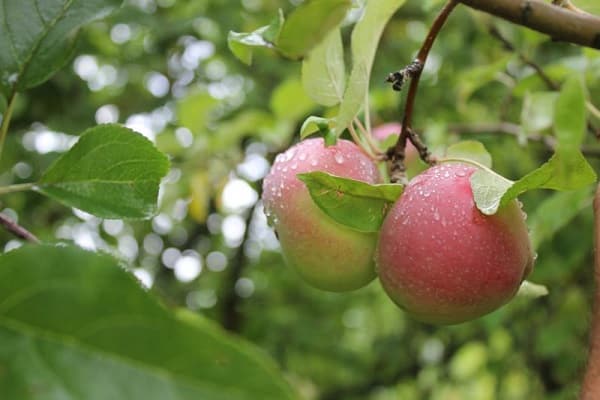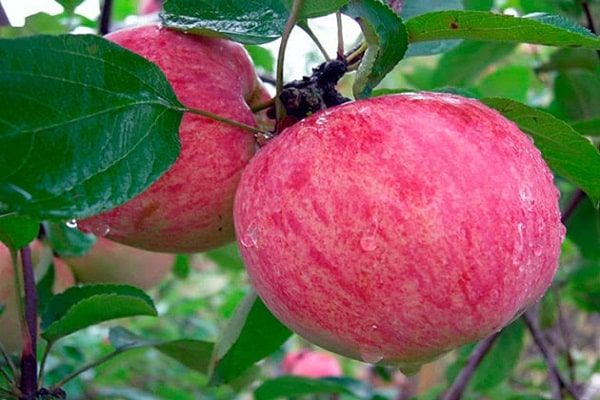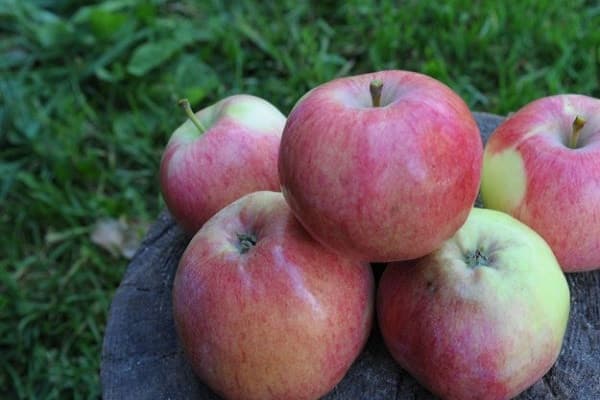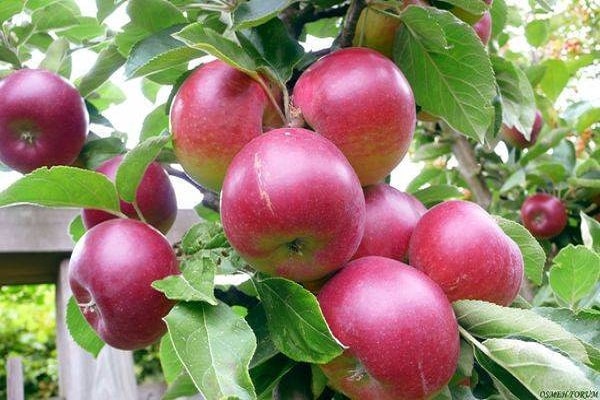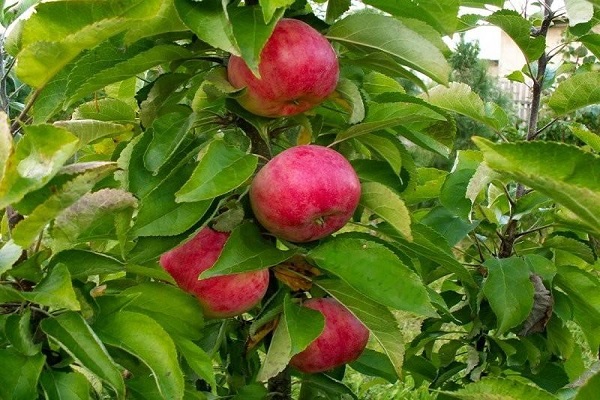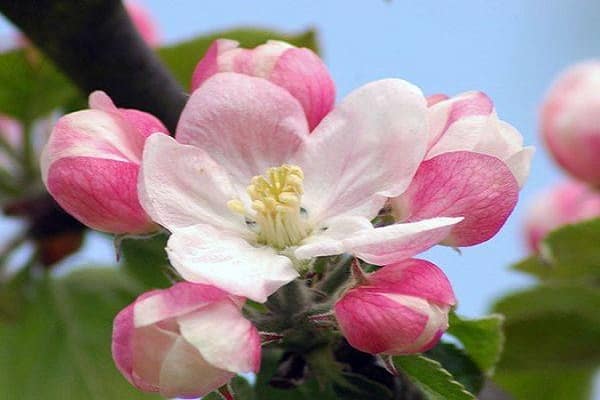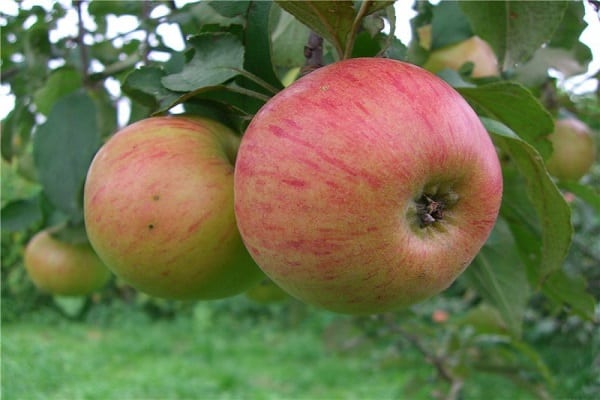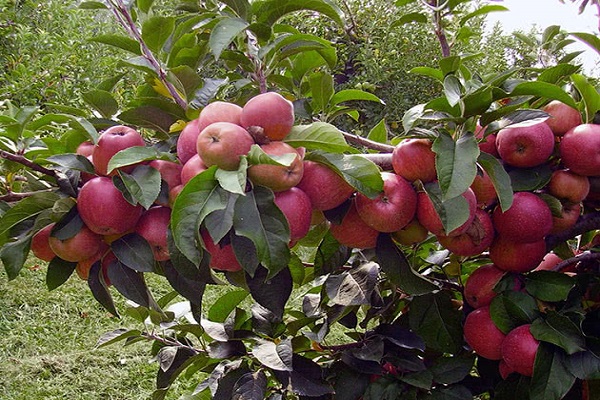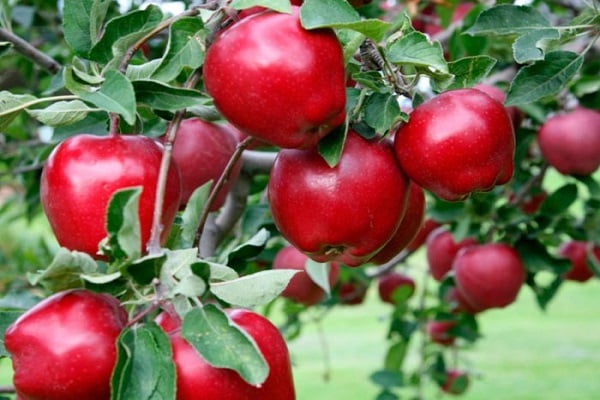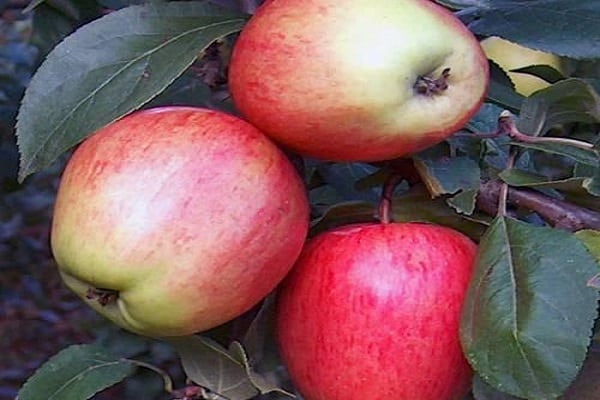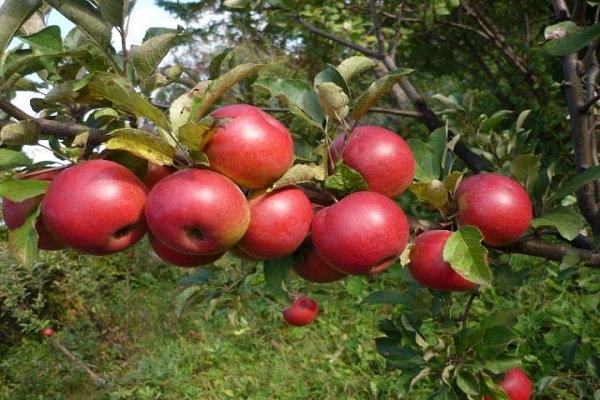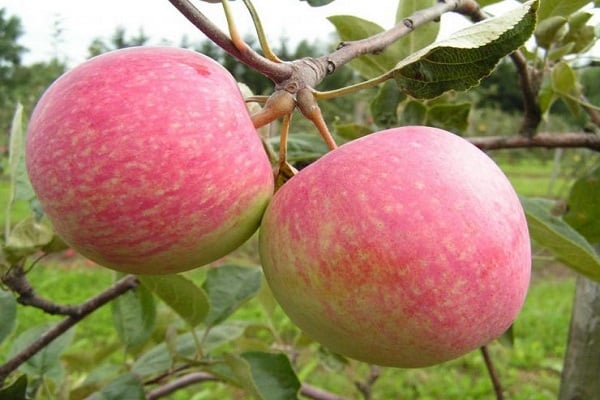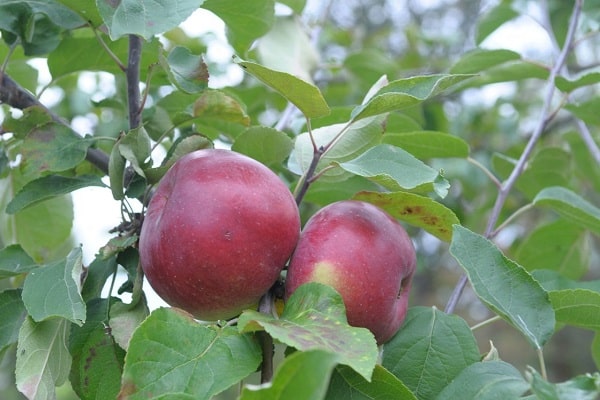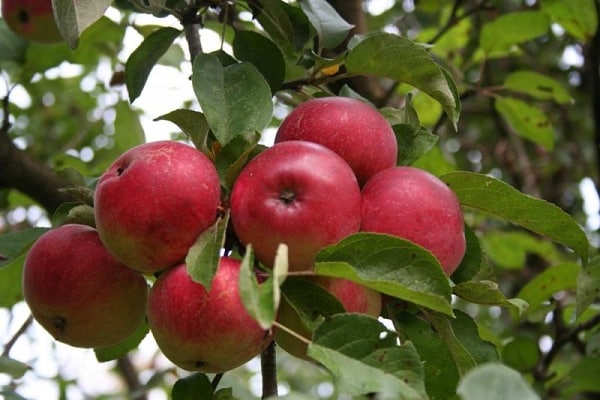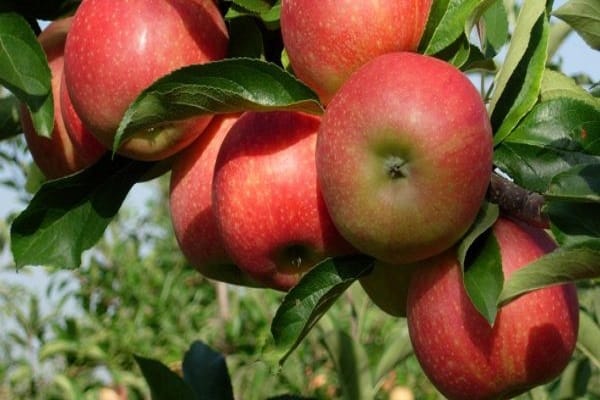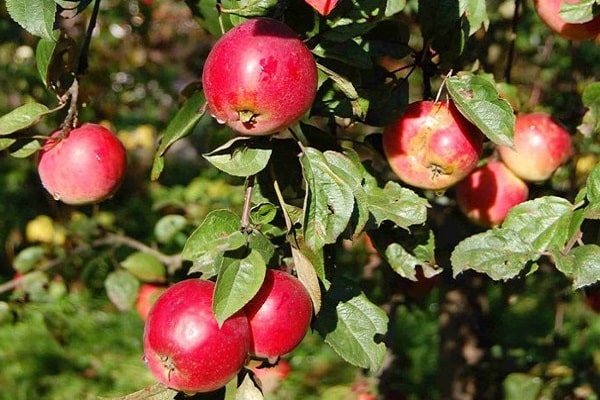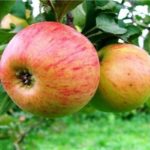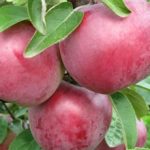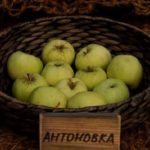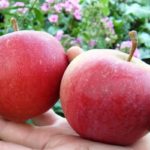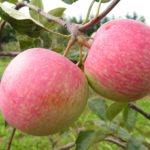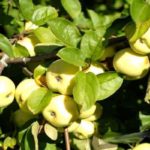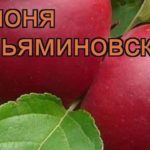The early winter variety of the Cherry apple tree was obtained by crossing the Antonovka ordinary and Pepin Shafranny varieties. Bred at VNIIS named after. Michurin, the originators of the variety are breeders Z. I. Ivanova, V. K. Zaets, S. I. Isaev and G. A. Lobanov. The Cherry variety apple tree is suitable for growing in the southern regions of Central Russia - Tambov, Kursk, Lipetsk, Voronezh regions.
- Variety description
- Tree morphology
- Crown and branches
- Trunk
- Foliage
- Escapes
- Kidneys
- Flowers
- Fruit
- Advantages and disadvantages of the variety
- Subspecies
- Columnar version
- Early winter apple tree Cherry
- Characteristics of the Cherry variety
- Pollination
- Growth
- Precocity
- High yield
- Frost resistance
- Disease resistance and pest resistance
- Apple Cherry - description
- Taste and aroma of apples
- Beneficial features
- Nutrient content of apple
- The benefits and harms of eating fruits
- Cooking recipes
- Planting seedlings
- Preparing the land for planting
- Site marking
- Setting the stage
- Planting hole dimensions
- Selection of seedlings
- When to land
- Sequence of actions during disembarkation
- Agrotechnical works
- Trim and shape the crown
- Care during flower pollination
- Watering
- Protection against diseases
- Fertilizer
- Maturation
- Fruiting
- Harvest
- Fruit collection
- Storage and transportation
- Features of cultivation in the regions
- Moscow region
- Middle lane
Variety description
Cherry apple tree is a high-yielding variety with average winter hardiness. Slightly susceptible to freezing in a temperate continental climate with relatively mild, snowy winters (negative temperatures fluctuate at -8...-11˚С). Can tolerate frosts down to -27 ˚С.
Tree morphology
The Cherry apple tree is a medium-sized species, growing up to 2-3 meters in height, the roots lie to a depth of 50-60 cm.
Crown and branches
The tree has a rounded, medium-leaved crown with a diameter of 1.5-2 m. The branches grow almost horizontally to the ground and are compactly located.
Trunk
The trunk, branches and shoots of the apple tree are covered with nasty, dense bark of an intense dark cherry tone.
Foliage
The leaves are smooth, oval, slightly pubescent on the back, and have fine serrations along the edges. The petioles are of medium length, fleecy, colored at the base, growing on the shoots at an acute angle.
Escapes
The Cherry variety tree produces straight shoots of medium length and thickness, with shortened internodes and a characteristic cherry color, covered with many small lenticels.
Kidneys
At the end of annual fruit twigs and spears, medium-sized buds are formed. They are afraid of returning spring frosts.
Flowers
The flowers of the Cherry apple tree are medium in size, forming inflorescences of 4 pieces. The oval petals are white or cream in color, the stigmas of the pistils and stamens are at the same height.
Fruit
Apples of the Cherry variety have a regular round or slightly conical shape and thin skin. The fruits are large, grow up to 110-140 grams, yellow-green at the stage of technical ripeness. Upon reaching full ripening, they gradually acquire a crimson-red hue. The pulp has a dense structure, sweet, juicy, with slight sourness and a weak aroma.
Advantages and disadvantages of the variety
The Cherry apple tree variety is distinguished by good yield and consumer properties of the fruit. The following characteristics are important:
- regularity of fruiting;
- bright appearance of fruits;
- The fruits are hardy for transportation and have good keeping quality.
The disadvantages of the variety include low immunity to frost, drought, and diseases.
Subspecies
Medium-sized types of apple trees are grown by grafting cuttings onto a rootstock with moderate growth. The compactness of the tree allows it to be grown in small areas and harvested without difficulty.
Columnar version
Columnar apple trees have become very popular. A low tree strewn with fruits looks impressive and does not take up much space. It is characterized by a thicker trunk, low height, and a small number of lateral branches growing along the trunk. The trunk and branches of the apple tree are densely covered with short annual shoots on which fruits are formed. The compact crown of such a column is easier to protect from frost in winter. The Cherry variety tree bears fruit from the 2-3rd year.
Early winter apple tree Cherry
A medium-sized apple tree is a delicate plant that requires careful care and feeding. The superficial location of the root system allows planting a tree with a relatively shallow groundwater table. In order to prevent the tree from falling during strong winds or softening of the soil during rains, it should be tied to special supports. Fruiting of the apple tree begins in the 5th year.
Characteristics of the Cherry variety
If all agrotechnical measures are carried out, the Cherry apple tree lives on average 10-15 years, after which the plantings should be renewed. Compared to tall varieties, it tolerates cold better, is more resistant to diseases, its fruits are larger and sweeter.
Pollination
The Cherry variety is self-sterile and requires the presence of pollinating plants. Suitable for this purpose:
- Pepin Saffron.
- Northern Sinap.
- Antonovka vulgare.
Growth
The development of annual shoots depends on care - watering, fertilizing and proper pruning. On average, new branches grow up to 15 cm.
Precocity
Harvesting the fruits of the Cherry variety begins in September at the stage of removable ripeness. Full maturity is reached in 2 weeks. The fruits are stored for 5 months without loss of commercial quality.
High yield
The apple tree bears fruit annually and abundantly. From one plant, including an adult one, you can get up to 150 kg of harvest with proper care.
Frost resistance
The Cherry variety is characterized by average frost resistance and is not suitable for growing in regions with harsh winters. Young shoots and buds are most susceptible to freezing, which inevitably affects the harvest. Flowers are afraid of return frosts. The plant recovers well after cold damage.
Disease resistance and pest resistance
Apple trees of the Cherry variety have good resistance to scab, and against other diseases - cytosporosis, fruit rot and pests, appropriate measures must be taken.
Apple Cherry - description
Large fruits are located on a short thick stalk. The medium-depth funnel is devoid of the “rusty” coating characteristic of many varieties. The saucer is small, with a closed, non-falling cup. The seed box contains large, half-open chambers. The seeds are small, dark cherry color.
Taste and aroma of apples
The fruits of the Cherry apple tree have white, crisp, juicy pulp with a delicate dessert taste and a harmonious combination of sugars and acids. The aroma is weak.
Beneficial features
Apples have a positive effect on human health. The presence of antioxidants gives them the ability to rejuvenate the body and inhibit the aging process of cells. Regular consumption of apples has a general strengthening effect:
- improves the functioning of the immune and cardiovascular systems;
- leads to a decrease in cholesterol levels;
- helps eliminate toxic substances and slow down the development of cancer cells;
- normalizes the functioning of the digestive system.
Nutrient content of apple
The fruit is low in calories (48 kcal), but has high nutritional value:
| Vitamins | Content
mg/100 g |
Minerals | Content
mg/100 g |
| A | 0,005 | Ca | 16 |
| IN 1 | 0,03 | TO | 278 |
| AT 2 | 0,02 | Fe | 2,5 |
| AT 5 | 0,07 | Zn | 0,15 |
| AT 6 | 0,08 | Mg | 9 |
| AT 9 | 0,002 | P | 11 |
| WITH | 10 | S | 5 |
| E | 0,0002 | Cl | 2 |
| TO | 0,002 | B | 0,25 |
| RR | 0,3 |
The benefits and harms of eating fruits
One fresh apple covers the body's daily need for vitamins and minerals by 20%. It is better to eat them with the peel, which contains a lot of fiber. The fruit is hypoallergenic and can be safely introduced into children's diets from infancy into complementary foods.Diabetics should be careful. There are few contraindications to eating apples; they are associated with individual intolerance to the product, exacerbation of gastric and intestinal ulcers.
Cooking recipes
The fruits of the Cherry apple tree can be consumed fresh, squeezed juice, prepared compotes, fruit drinks, jelly, used in the preparation of confectionery and hot dishes, and canned for long-term storage.
Planting seedlings
For the Cherry apple tree, you should choose a well-lit, sunny area with fertile soil and no possibility of stagnation of melt or rain water. The tree develops well and bears fruit on chernozems, sandstones and loams with a low acidity level. The area should be well protected from the winds, where snow is not blown away, so that it is easier for the tree to winter.
Preparing the land for planting
In the fall, the site is dug up and weeds are removed. Add sand, sawdust, plant humus or compost to dense, heavy soil. Light sandy soils are made heavier by adding clay, peat, rotted manure and ash.
Site marking
When planting apple trees of the Cherry variety, a distance between plants in a row should be at least 3.5 meters and between rows - about 4.5 meters. Columnar seedlings are planted according to a 1 x 1 meter pattern. If distance is not maintained, the tree may not have enough nutrients and sunlight, which will lead to a deterioration in the quality and volume of the harvest, decreased immunity and greater susceptibility to disease.
Setting the stage
To enrich the soil, 30 kg of fertile soil, peat and rotted manure should be added directly into the hole. It would also be good to add half a kilo of wood ash, 125 g of potassium sulfate and 400 g of superphosphate.
Planting hole dimensions
The health of the plant depends on the preparation of the planting pit; it should provide a nutritional complex for the seedling. Its depth and diameter should be 70 cm. If groundwater lies above 1.5 meters from the surface, it is necessary to make an elevation, and only then dig a hole.
Selection of seedlings
Seedlings should be purchased from organizations that specialize in breeding plants that have a good reputation. 1-2 year old specimens take root best. When choosing a young apple tree for planting, you should inspect it. The roots must be intact, without growths, elastic and not brittle. The plant should not have any damage, no leaves, and be green in color under the bark.
When to land
It is best to plant apple trees in early spring or mid-autumn. In the spring, you should wait until the danger of frost has passed, but you should not delay, the buds on the seedling should not bloom. If you are late with spring planting, the young tree will get sick a lot and suffer from sunburn. In autumn, it is recommended to plant an apple tree in mid-October, 2 weeks before frost.. Seedlings with a closed root system can be placed in the ground from April to October - they will easily take root. The roots should not be cut.
Sequence of actions during disembarkation
Landing algorithm:
- You should dig a hole in a place prepared in advance; it is recommended to lay a drainage layer of small stones or broken bricks at the bottom.
- Fill it halfway with fertile soil and fertilizers.
- Secure the tree support a little to the side from the middle.
- Place the apple tree seedling in a hole so that the root collar rises above the soil level, cover it with soil and tie it to a support.
- Water the plant generously.
Agrotechnical works
The Cherry apple tree growing technology is aimed at ensuring high yields. The best result is achieved through plant care, soil enrichment, and pest control.
Trim and shape the crown
Pruning an apple tree is aimed at creating a compact crown. The central trunk should prevail in strength over the other branches. If any skeletal branch begins to grow along with the central conductor, it must be shortened to 2-3 buds. Using pruning, the direction of growth of apple tree branches is regulated; thinning ensures sufficient light supply to all parts of the crown. This event should be held regularly, at least once a year. The following branches should be deleted:
- sick, broken, frostbitten, severely damaged by pests;
- growing vertically or at an acute angle to the trunk;
- intersecting, growing downwards and directed towards the trunk;
- the strong upper branches of the apple tree are shortened, leaving 2-4 buds;
- wolf shoots, shoots at the trunk and from the roots.
Care during flower pollination
In spring, the apple tree blooms profusely and sets fruit. To improve the quality of the future harvest, the inflorescences are thinned out, leaving 2-3 flowers. Weak fruit branches located in the shade are also removed. After the formation of ovaries, thinning is repeated, removing damaged, weak, deformed, and shaded ones. In the spring, it is recommended to whiten the trunks of the apple tree, which will help protect the bark from overheating in the summer.
Watering
Apple trees need to be watered 4 times during the summer - abundantly and at a certain moment:
- before buds open;
- 2-3 weeks after flowering;
- 2-3 weeks before harvest;
- when preparing the apple tree for winter, in October.
A folk superstition states that you should pour as many buckets of water into the roots of an apple tree as it is old.
Protection against diseases
The apple tree is susceptible to damage by viruses and fungi. The most common are powdery mildew, scab, rot, cytosporosis, and bacteriosis. Thinning the crown, draining and loosening the soil, and timely removal of affected parts of the plant help prevent diseases.
It is recommended to spray the apple tree with fungicides, antibacterial compounds, copper sulfate, and Bordeaux mixture 3-4 times during the growing season. Aqueous solutions of mineral fertilizers are good in the fight against fungi - 15% potassium salt, 10% ammonium nitrate, 10% ammonium sulfate, which are sprayed on trees.
Insecticides that are effective against insects are “Aktara”, “Karate”, “Confidor”, “Arrivo”. The apple tree is treated repeatedly - during the swelling of the buds, after flowering, during the ripening of the fruits. Folk remedies include decoctions of elderberry, calendula, tobacco, and soap solution.
Treatments with poisons should be stopped a month before harvest.
Fertilizer
To ensure good development of the Cherry variety apple tree and increase productivity, the soil in the tree trunk circle is regularly loosened and weeds are removed. Fertilizing with complex mineral fertilizers should begin in the second year, taking into account the age and area to be fertilized. Also, as a top dressing, slurry, bird droppings, peat fecal or plant compost are added to the roots of the apple tree.
Maturation
During the ripening of the fruits of the Cherry apple tree, it is necessary to take care of the safety of branches that can break under load. Those located at an acute angle to the trunk are especially susceptible to this. This problem is solved by installing supports or tying it to a wire ring attached to the stem.
Fruiting
During the period of fruiting of the Cherry variety, it is recommended to plant peas, mustard, and alfalfa in the spaces between the rows, which will absorb excess moisture, not allowing the apple tree to outgrow; subsequently, the green mass can be mowed and embedded in the ground. In August, it is useful to cover the trunks with a mixture of 4 parts clay, 1 part mullein and 1 part ash, diluted to the consistency of liquid sour cream. You can add 0.5 cups of urea and 3 tablets of microelements to the composition.
Harvest
The fruits of the Cherry apple tree are harvested upon reaching removable maturity, when they acquire the color characteristic of the variety and stop gaining weight. If the fruits are not removed from the tree in time, they will soon begin to fall to the ground.
Fruit collection
Removing apples from a tree follows the following basic rules:
- the best time is early morning, after the fruits have cooled at night;
- move from the lower branches of the apple tree to the upper ones;
- act carefully, avoiding damage to the fruit when removing from the branch and placing in a container;
- You cannot harvest during rain or immediately after watering - apples must be dry;
- After collection, they need to be cooled to +4 ˚С.
Storage and transportation
Apples can be transported by any type of transport that provides protection from temperatures below 0 °C and precipitation.
The fruits of the Cherry variety are stored for up to 5 months if the following conditions are met:
- Fruits must be harvested at the stage of technical ripeness. Unripe and overripe apples are poorly stored and the flesh quickly darkens.
- 2-3 weeks before harvesting, stop watering and fertilizing.
- Immediately after harvesting, the fruits must be cooled to +4 ˚С.
- Apples wrapped in oiled thin paper are stored for a long time.
- Optimal storage temperature is +2…+4 ˚С.When stored without special refrigeration, the shelf life of the fruit is halved.
Features of cultivation in the regions
When choosing a Cherry apple tree variety, you should find out whether it is suitable for growing in a given region. The plant is characterized by low resistance to frost; planting in cold regions - in Siberia, the Urals - will not bring the desired results, and the tree may even die.
Moscow region
The temperate continental climate of the Moscow region generally allows for the cultivation of the Cherry variety apple tree. But the plant should be protected from piercing cold winds in winter and spring frosts that damage the flowers. Trees should be covered.
Middle lane
An early winter, frost-resistant variety of the Cherry apple tree grows better in the southern regions of central Russia. With proper care and measures aimed at protecting the plant from adverse natural phenomena, it is possible to grow it throughout the Central Zone and obtain a good harvest.

